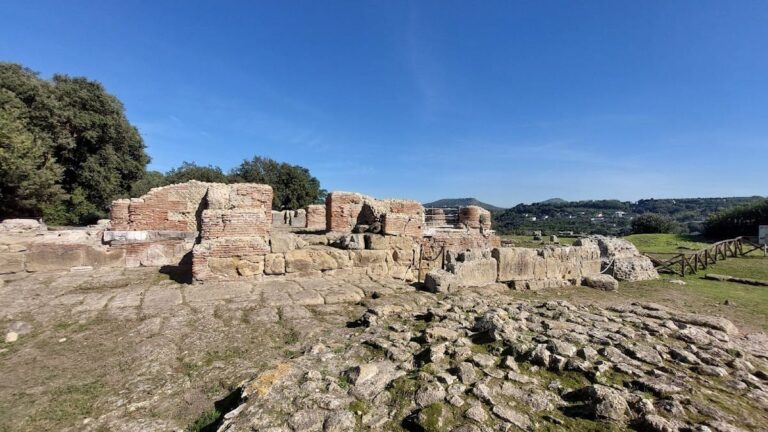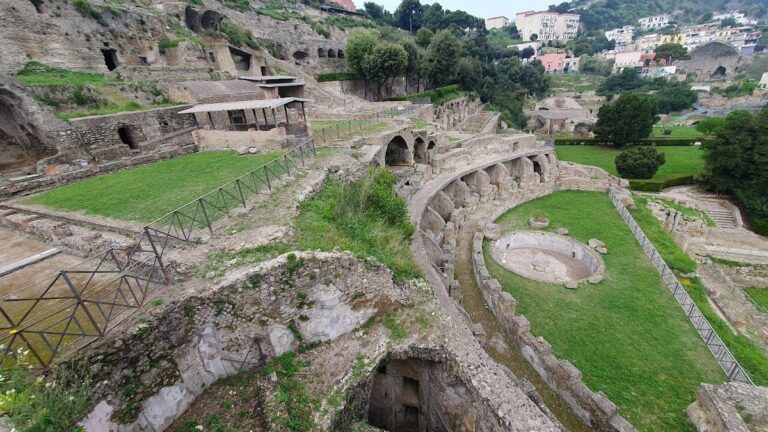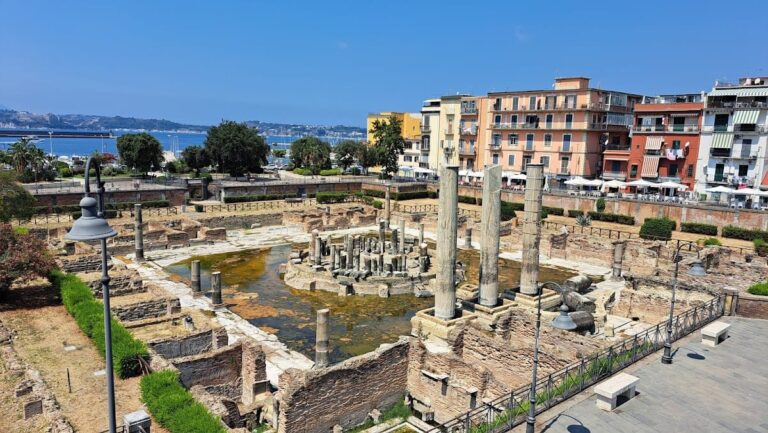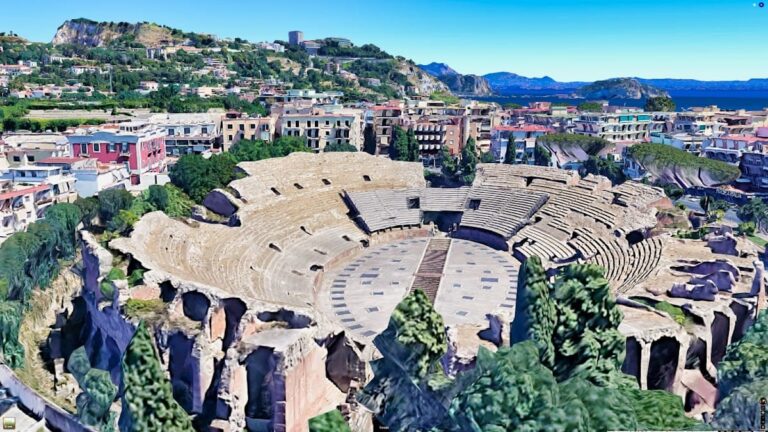Liternum: A Roman Colonial Settlement in Campania, Italy
Table of Contents
Visitor Information
Google Rating: 4
Popularity: Low
Google Maps: View on Google Maps
Official Website: www.pafleg.it
Country: Italy
Civilization: Roman
Remains: Burial, City, Civic, Domestic, Economic, Entertainment, Infrastructure, Religious, Sanitation
Context
Liternum is situated near the contemporary town of Giugliano in Campania, within the metropolitan area of Naples, Italy. The site occupies a low-lying coastal plain adjacent to the ancient Lago Patria, a lagoon historically connected to the Tyrrhenian Sea. This marshy environment shaped the settlement’s spatial organization and access to marine resources. The surrounding fertile plains supported agricultural production, while proximity to the sea facilitated fishing activities and limited maritime exchange. Positioned along the Campanian coastline, Liternum formed part of a network of Roman and pre-Roman settlements that structured southern Italy’s coastal landscape.
Archaeological data confirm that Liternum was founded during the Roman Republic and remained occupied through the Imperial period. The site is historically significant for its association with the Roman general Scipio Africanus, who retired there in the 2nd century BCE. Environmental transformations, including lagoon silting and malaria outbreaks, contributed to the settlement’s decline in late antiquity, culminating in abandonment by the early medieval era. Modern archaeological investigations have documented the site’s urban fabric and infrastructure, with conservation efforts aimed at preserving extant ruins and mitigating threats from natural and anthropogenic factors. Liternum continues to provide valuable insights into Roman colonial settlement patterns and coastal dynamics in Campania.
History
Liternum’s historical development exemplifies the evolution of a Roman colonial town on the Campanian coast, reflecting broader regional and imperial processes from the Republican era through late antiquity. Established as a Roman colony in the aftermath of the Second Punic War, it served as a settlement for veteran soldiers and became linked to prominent figures such as Scipio Africanus. Over subsequent centuries, Liternum integrated into the Roman imperial system, benefiting from infrastructural projects like the Via Domitiana. However, environmental degradation and political disruptions in late antiquity precipitated its decline and eventual desertion. The site’s history illustrates the challenges faced by smaller Roman colonies in maintaining urban vitality amid shifting economic, health, and military conditions.
Pre-Roman and Oscan Period
Prior to Roman colonization, the area encompassing Liternum was inhabited by Oscan-speaking populations, indicating a longstanding indigenous presence in the region. The settlement likely functioned within the sphere of influence of the nearby Greek city of Cumae, which dominated the coastal plain during the archaic and classical periods. Archaeological and linguistic evidence situates Liternum within a network of indigenous and Hellenic communities that characterized pre-Roman Campania. Despite this, no substantial urban remains from this period have been identified at Liternum, suggesting its role was limited and subordinate until the establishment of the Roman colony.
Roman Colony Foundation and Republican Period (194–1st century BCE)
Liternum was founded as a Roman colony in 194 BCE, contemporaneously with Puteoli and Volturnum, as part of Rome’s strategy to consolidate control over Campania following the Second Punic War. The colony was likely settled by veterans, including soldiers who had served under Scipio Africanus. The urban plan incorporated a forum measuring approximately 97 by 42 meters, porticoed on three sides, with the Capitolium and Basilica situated on the northern side, both dating to the 2nd century BCE. A small theater was constructed by the end of the century, indicating the development of public entertainment facilities. Literary sources, including Livy and Ovid, reference Liternum, with Ovid noting the presence of mastic trees in the vicinity. Scipio Africanus retired to Liternum around 187 BCE and died there in 183 BCE; his villa and tomb became notable landmarks, described by Seneca the Younger as constructed with squared stone blocks and flanked by towers. Archaeological investigations have also identified Republican-period temples and thermal buildings, underscoring the colony’s organized civic and religious life during this era.
Augustan and Imperial Roman Period (1st century BCE – 3rd century CE)
During the Augustan period and into the 1st and 2nd centuries CE, Liternum experienced demographic and economic growth linked to its integration into the Roman imperial infrastructure. The construction of the Via Domitiana connected the colony to other coastal centers and the major port of Puteoli, enhancing its administrative significance as a prefecture. The road traversed the forum, necessitating partial reconstruction of the porticoes. Archaeological evidence reveals a diversified economy including workshops producing ceramics, perfumes, and possibly glass, exploiting local white sand deposits. Fishing remained a staple economic activity. The amphitheater, originally built in the late Republican period and expanded during the early Empire, reflects the city’s social and cultural development. The necropolis, primarily dating to the 2nd century CE, contains a variety of tomb types such as cappuccino tombs, enchytrismos burials, and brick box tombs, alongside funerary enclosures with painted plaster walls and a quadrangular mausoleum constructed in opus reticulatum. A deep masonry well within the necropolis likely served ritual functions. Notably, a marble funerary inscription commemorates a gladiator, indicating the presence and social recognition of such individuals within the community. Artifacts recovered from funerary contexts, including coins, oil lamps, and ceramics, provide further insight into the colony’s cultural practices and daily life.
Late Antiquity and Decline (4th–5th century CE)
From the 4th century CE onward, Liternum underwent a period of decline influenced by environmental and health challenges, notably malaria outbreaks that rendered the coastal plain increasingly inhospitable. The population gradually diminished as inhabitants relocated inland, contributing to the foundation of the early settlement that would become modern Giugliano. In 455 CE, the town suffered destruction during a Vandal raid led by King Genseric, marking a significant episode in its decline. Despite this, Liternum retained ecclesiastical importance as a bishopric, known as ecclesia Liternina or Patriensis, during the Christian period. The transfer of the relics of Saint Fortunata to Naples signaled a shift in religious focus. Subsequently, the surrounding plain became the site of Benedictine monastic settlements, reflecting a transformation in land use and spiritual organization following urban abandonment.
Modern Rediscovery and Archaeological Excavations (19th–21st century CE)
The location of ancient Liternum was identified in the late 19th century through the discovery of inscriptions. Systematic archaeological excavations commenced in the 1930s under the direction of Amedeo Maiuri, revealing key structures including the forum, Capitolium, basilica, theater, amphitheater, and segments of the Via Domitiana. The necropolis was identified in the early 2000s along the northern lakeshore, providing new data on funerary customs. In 1936, a votive altar dedicated to Scipio Africanus was erected within the archaeological park. Many artifacts recovered during excavations are housed in the Archaeological Museum of the Phlegraean Fields. Since 2006, coordinated efforts by local authorities and heritage institutions have led to the establishment and enhancement of the Liternum Archaeological Park and Museum, completed in 2009 and incorporated into the Parco archeologico dei Campi Flegrei in 2016. Recent restoration projects, including those completed in 2024, have improved site accessibility and conservation. Ongoing research, including recent necropolis excavations led by Dr. Simona Formola, continues to refine understanding of Liternum’s urban development, funerary practices, and social dynamics.
Daily Life and Importance by Period
Roman Colony Foundation and Republican Period (194–1st century BCE)
Following its establishment as a Roman colony for Second Punic War veterans, Liternum developed a structured urban environment embodying Roman civic principles. The population comprised primarily Roman settlers, including retired soldiers from Scipio Africanus’s forces, alongside assimilated local Oscan inhabitants. Social organization likely featured patriarchal family units and a stratified society with elite landowners and magistrates, though epigraphic evidence naming officials is limited. Economic activities centered on agriculture, exploiting the fertile coastal plain for cultivation of grains, olives, and possibly vineyards. Fishing supplemented dietary needs, utilizing the adjacent lagoon and sea. Public amenities such as thermal baths and a small theater indicate communal leisure and social interaction. Domestic architecture, exemplified by Seneca’s description of Scipio’s villa with squared stone masonry and towers, likely included painted walls and modest furnishings typical of Roman Republican homes. The forum, with its porticoes and temples including the Capitolium and Basilica, functioned as the civic and religious nucleus, hosting markets, judicial proceedings, and religious ceremonies. Trade and goods procurement occurred locally and through nearby centers such as Cumae and Puteoli, accessed via land and coastal routes. Religious observance focused on traditional Roman deities, supported by temple cults and communal festivals.
Augustan and Imperial Roman Period (1st century BCE – 3rd century CE)
During the Augustan and Imperial periods, Liternum’s population expanded and diversified, incorporating artisans, merchants, and administrative personnel alongside rural inhabitants. The city’s elevation to prefecture status and integration into the imperial road network, notably the Via Domitiana, enhanced regional connectivity and administrative functions. Local governance likely included magistracies such as duumviri, consistent with Roman colonial institutions, though direct epigraphic attestations are scarce. Economic activities broadened to encompass workshops producing ceramics, perfumes, and possibly glass, capitalizing on local sand resources. Fishing remained a significant livelihood, while trade increased due to improved transport infrastructure. The amphitheater’s construction and subsequent enlargement attest to an active social life featuring public spectacles. Residential architecture incorporated mosaic floors and painted plaster walls, reflecting Roman aesthetic preferences. Household layouts included courtyards, kitchens, and storage spaces, supporting complex family and social arrangements. Dietary staples comprised bread, olives, fish, and wine, aligning with regional culinary patterns. Clothing adhered to Roman styles, with wealthier citizens displaying finer textiles and adornments. Markets in the forum and along the Via Domitiana offered a range of local and imported goods. Religious life persisted with temples and shrines, while funerary customs became increasingly elaborate, as evidenced by diverse tomb types and ritual installations in the necropolis. The presence of a gladiator’s funerary inscription indicates the integration of entertainers within the community’s social fabric.
Late Antiquity and Decline (4th–5th century CE)
From the 4th century CE, Liternum experienced demographic contraction and economic decline, largely attributable to environmental degradation and recurrent malaria outbreaks. The population diminished as families relocated inland, establishing the early settlement that evolved into modern Giugliano. Social organization transitioned from Roman municipal governance to a Christian ecclesiastical framework, with Liternum serving as a bishopric (ecclesia Liternina or Patriensis). Clerical authorities assumed leadership roles, overseeing religious life and community cohesion. Agricultural activity likely persisted on a reduced scale, while trade and artisanal production waned. Domestic life became simpler, with diminished resources for elaborate decoration or public entertainment. The sack by Genseric in 455 CE further destabilized the settlement, accelerating abandonment. Religious practices centered increasingly on Christianity, with the transfer of Saint Fortunata’s relics to Naples symbolizing a shift in spiritual focus. Monastic establishments later occupied the surrounding lands, reflecting a transformation from urban to rural religious landscapes. The Via Domitiana’s importance declined, and the community’s civic role diminished accordingly. Family and social structures adapted to prioritize health and security over urban life.
Remains
Architectural Features
The archaeological remains at Liternum document a Roman colonial settlement characterized by a planned urban layout and a combination of civic, religious, residential, and funerary structures. The site is located on a coastal plain, with construction employing local materials such as squared stone blocks and tuff masonry. The urban core centers on a rectangular forum approximately 97 by 42 meters in dimension, porticoed on three sides. The Via Domitiana, constructed in the early Imperial period, traversed the forum along a north-south axis, interrupting and necessitating partial reconstruction of the porticoes. The settlement expanded modestly during the Augustan and Imperial eras, incorporating entertainment venues and a necropolis. Construction techniques include opus reticulatum masonry in funerary monuments and ashlar blocks in civic buildings. Some structures exhibit evidence of remodeling during the 1st and 2nd centuries CE. Preservation varies from substantial masonry remains to low walls and surface traces, reflecting differential survival and excavation coverage.
Key Buildings and Structures
Forum
The forum, established at the colony’s foundation in 194 BCE, served as the civic and religious center of Liternum. This large rectangular space, measuring approximately 97 meters in length and 42 meters in width, was surrounded by porticoes on three sides. The northern side accommodated the Capitolium and Basilica, both dating to the 2nd century BCE. The paved Via Domitiana, constructed in the early 1st century CE, passed through the forum’s center along a north-south axis, cutting through the portico and prompting partial reconstruction of the colonnades. Excavations conducted in the 1930s revealed the forum’s layout and associated architectural elements, confirming its role as the focal point of public life.
Capitolium
Situated on the northern side of the forum, the Capitolium dates to the 2nd century BCE and was partially excavated during the 1930s. The remains consist of foundations and wall fragments constructed with squared stone blocks. The temple’s rectangular plan aligns with typical Roman Capitolia dedicated to the Capitoline Triad. Although detailed architectural features are fragmentary, its location adjacent to the basilica and forum underscores its religious significance within the colony’s civic center.
Basilica
Adjacent to the Capitolium on the forum’s northern side, the basilica also dates to the 2nd century BCE. Excavations uncovered its rectangular footprint, including portions of walls and foundations built from local stone blocks. The basilica likely functioned as a venue for judicial and administrative activities, consistent with Roman civic architecture. The ruins remain visible near the forum area, providing insight into the colony’s institutional framework.
Temple (Unnamed)
Within the forum precinct, surface remains and architectural fragments attest to an additional temple dating to the Republican period (2nd–1st century BCE). Although not fully excavated, the foundations and scattered stone elements confirm its presence as part of the early urban fabric, contributing to the colony’s religious landscape.
Thermal Building (Baths)
A thermal complex dating to the Republican period (2nd–1st century BCE) was identified near the forum. Archaeological investigations uncovered structural remains consistent with bathing facilities, including wall foundations and evidence of hypocaust heating systems. The baths’ layout and construction materials remain partially documented, with no extensive decorative elements reported. This facility indicates the provision of public hygiene and social amenities within the colony.
Theater
The small theater, constructed in the late 2nd century CE, is located adjacent to the forum. Surviving elements include the cavea (seating area) and the skenè (stage building). The cavea’s semicircular arrangement of seats is partially preserved, while the skenè’s foundations and wall fragments provide insight into the theater’s architectural design. The modest size of the theater suggests it served local-scale performances and community gatherings.
Amphitheater
Positioned outside the city walls near the southern lakeside area, the amphitheater dates to the 1st century BCE, with restorations and expansions during the 1st and 2nd centuries CE. Measuring approximately 85–90 meters by 65–70 meters, the elliptical structure was designed for gladiatorial games and public spectacles. Remains include portions of the arena, seating tiers, and external walls. The amphitheater is incorporated into the archaeological park and has undergone conservation since its inclusion in the Parco archeologico dei Campi Flegrei in 2016.
Necropolis
The necropolis lies outside the city walls, near the forum and amphitheater, covering an area exceeding 150 square meters. It dates from the late 1st century BCE to the 3rd century CE and contains over twenty burials exhibiting diverse Roman funerary practices. Tomb types include cappuccino tombs characterized by gabled roof tiles, enchytrismos burials where remains were placed in large terracotta jars, and brick box tombs. Two funerary enclosures with partially preserved white plaster walls decorated with red motifs have been documented. A central quadrangular mausoleum constructed in opus reticulatum with large gray tuff blocks contains plastered niches for cinerary urns. A deep masonry well within the necropolis likely served cultic or funerary functions. A marble funerary inscription commemorates a gladiator, indicating the presence and commemoration of such figures within the community. Artifacts recovered include coins, oil lamps, and ceramic vessels, contributing to the understanding of funerary customs and daily life.
Villa and Tomb of Scipio Africanus
The villa and tomb of Scipio Africanus, historically attested and described by Seneca the Younger, were located within the settlement. The villa was constructed with squared stone blocks and flanked by towers on both sides. The tomb bore the epitaph “Ingrata patria, ne ossa quidem mea habes” (“Ungrateful homeland, you do not even have my bones”). Early 20th-century excavations focused on this area, though precise remains are limited. A votive altar dedicated to Scipio Africanus was erected in the archaeological park in 1936, commemorating his association with the site.
Other Remains
Surface traces and low walls of various unidentified buildings have been recorded across the site, including possible domestic structures and workshops. Evidence for perfumeries and ceramic production is suggested by artifact finds, although no specific buildings have been conclusively identified. Remains of a possible cistern or water-related infrastructure have been noted but remain unexcavated. These scattered remains contribute to understanding the settlement’s spatial organization beyond the principal civic and entertainment buildings.
Archaeological Discoveries
Excavations at Liternum have yielded a range of artifacts spanning the Republican through Imperial periods. Pottery assemblages include local and imported amphorae and tableware, reflecting domestic consumption patterns. Numerous coins from various imperial reigns have been recovered, aiding chronological frameworks. Inscriptions include dedicatory texts, notably the marble funerary inscription for a gladiator found in the necropolis. Domestic objects such as oil lamps and ceramic vessels were recovered from both residential and funerary contexts. Religious artifacts include altars and votive offerings, including the ara votiva dedicated to Scipio Africanus. Tools related to craft activities have been identified, supporting evidence of workshops and artisan production within the settlement.
Preservation and Current Status
The ruins of Liternum are partially preserved, with the forum, Capitolium, basilica, theater, amphitheater, and necropolis visible as ruins or foundations. Some structures, such as the amphitheater and forum porticoes, retain substantial masonry, while others survive only as low walls or surface traces. Restoration and stabilization efforts have been undertaken since the early 20th century, with major conservation projects completed in 2009 and further enhancements in 2024. These interventions focus on preserving original materials and preventing further deterioration. The site is protected under Italian heritage laws and managed by local authorities. Environmental factors such as vegetation growth and past lagoon silting have affected preservation, but no significant modern development intrudes on the core archaeological areas.
Unexcavated Areas
Several parts of Liternum remain unexcavated or insufficiently studied. These include zones adjacent to known structures where surface surveys have identified low walls and architectural fragments. The possible cistern or water infrastructure near the forum has not been fully explored. Some residential quarters and workshop areas are only partially documented. Modern land use and conservation policies limit extensive excavation, but geophysical surveys and targeted excavations are planned to clarify the settlement’s full extent and urban layout. Future research aims to better understand the relationship between the city’s core and peripheral zones.









